|
A Sudanese Sirius System
by M. GRIAULE and G.
DIETERLEN
|
Note: The following article is
translated and published in its entirety. It is written for
professional anthropologists and ethnographers, and is presented
here for the reader who is sufficiently interested in the subject to
wish to pursue the source material. It is, therefore, supplementary
information, and is not essential for the reader who merely wishes
to follow the argument. |
FOREWORD
The indigenous knowledge about the Sirius system which is set forth
in this chapter has been gathered from four Sudanese peoples:
The main investigation was carried out among the Dogon between 1946
and 1950, where the four major informants were:
-
Innekouzou Dolo, a woman aged between sixty-five and seventy,
ammayana 'priestess of Amma', and soothsayer, living in the
Dozyou-Orey quarter of Ogol-du-Bas (Lower Ogol Sanga-du-Haut (Upper
Sanga). Tribe: Arou. Language: Sanga.
-
Ongnonlou Dolo, between sixty and sixty-five years old, patriarch of
the village of Go, recently established by a group of Arou in the
south-west of Lower Ogol. Language: Sanga.
-
Yebene, fifty years old, priest of the Binou Yebene of Upper Ogol,
living in Bara (Upper Sanga). Tribe: Dyon. Language: Sanga.
-
Manda, forty-five years old, priest of the Binou Manda, living in
Orosongo in Wazouba. Tribe: Dyon. Language: Wazouba.
The system as a whole was expounded by Ongnonlou, its various
details by the other informants. Although he was not responsible for
drawing up the Sigui calendar, Ongnonlou was acquainted with the
principles behind it and, during the periods when the investigators
were there, was able to obtain further information from the Arou at
Yougo Dogorou on the one hand and, on the other, from the permanent
steward of the supreme chieftain of the Arou at Arou-by-Ibi.2
Ongnonlou is in fact patriarch of the family from which the next
holder of the title will be designated when the next holiday comes
around.
Ongnonlou's learning, within an extremely secret body of knowledge,
thus represents an initial acquaintance or, to use a Bambara
expression, a 'slight acquaintance', and this point should be kept
in mind. Just as, for the layman, the star Sirius is the brightest
star in the sky, attracts his gaze, and plays the major role in the
computation of the Sigui, so the rules of the Sirius system as
revealed to the initiated in the first instance are at once
simplified in some parts and complicated in others, so as to divert
the attention from calculations which are more secret by far.
It must therefore be understood, once and for all, that the system
described here represents one phase of the revelations permitted to
initiates who are top-ranking but not specifically responsible for
the calculations to do with this part of the sky.
For our part, the documents gathered together have not given rise to
any original
hypothesis or research. They have been simply pieced together in
such a way that the accounts of the four principal informants are
merged into one and the same statement.
The problem of knowing how,
with no instruments at their disposal, men could know the movements
and certain characteristics of virtually invisible stars has not
been settled, nor even posed.
It has seemed more to the point, under
these special circumstances, to present the documents in the raw.
THE CALCULATION OF THE TIME OF THE SIGUI
Every sixty years8 the Dogon hold a ceremony called the Sigui
(ceremony). Its purpose is the renovation of the world, and it has
been described at length by them in 1931.4 Since the beginning of
this investigation, we were faced with the question of determining
the method used to calculate the period separating two Sigui
ceremonies. The common notion, which dates back to the myth of
creation, is that a fault in the Yougo rock, situated at the centre
of the village of Yougo Dogorou,8 lights up with a red glow in the
year preceding the ceremony.
This fault contains various altars, in
particular busts of Andoumboulou (the name given to the people of
small stature who formerly lived in the rocks), and a rock painting
called amma bara, 'god helps', to which we shall refer later.
Furthermore, and before this red glow appears, a spot situated
outside the village becomes covered with elongated gourds of a type
which no one would have sown.
When these signs are observed, an apparently simple procedure of
calculation is carried out, solely by the people of Yougo Dogorou
who belong to the Arou tribe:6 the council of elders assesses the
interval by means of thirty two-yearly drinking-bouts when beer made
from millet is drunk; and the eldest elder marks up each bout with a
cowrie shell.
These bouts are held about one month before the first rains,
sometimes in May or June, in a tent or shelter pitched to the north
of the village centre.7 But this rule is only theoretical: between
the last Sigui, celebrated at the beginning of the century, and
19318 there has been only one bout, halfway through the period; but
the two-yearly cowries were set down and gathered into a pile
representing the first thirty years. From 1931 onwards, the drinking
bouts took place every two years. When the second pile consisting of
fifteen cowries has been collected, the second Sigui of the
twentieth century will be celebrated.9
According to Manda, the priest, the calculation of the Sigui is
recorded above the door of the sanctuary of Binou by two figures
made of millet pulp representing the god
Amma and his son, Nommo, Instructor of the new world.10 The first
consists of a vertical oval - the egg of the world - and its major
axis, Amma in the original darkness. In the right-hand half, each
year is marked with a dot, starting from the bottom.
When the
seventh year comes round, a kind of trident is drawn on the outside,
as an extension to the line of dots. The same thing is done on the
left-hand side, in the order top-to-bottom. Fourteen years are
counted in this way: the seven twin years during which the world was
created, and to which a unit, symbolizing the whole, is added.11
Diagrammatically speaking, the figure shows the god's last gesture,
raising one hand and lowering the other, thereby showing that sky
and earth are made.
This drawing is repeated four times, making it possible to reckon a
period of sixty years; it is accompanied by the figure of the
Instructor,12 composed of two vertical legs supporting a head atop a
long neck. During the first thirty years which are recorded by two
ovals, the figure features only the right leg. During the second
thirty-year period, the left leg is made a little longer each year
in such a way that when the Sigui actually occurs it is the same
length as the right leg.
It is by allusion to this figure that
people talk about the Sigui 'getting to its feet' during this latter
period.
THE CALCULATION OF THE SIGUI CEREMONIES
When it is time for the Sigui, the elders gathered in the tana tono
shelter at Yougo draw a symbol on the rock with red ochre (fig. i),
which represents a kanaga mask;13 this, in turn, represents the god
Amma; a hole is made in the ground below it symbolizing the Sigui,
and thus Amma in the egg of the world. In effect these two signs
should be 'read' In the opposite order: Amma, in the shadow of the
egg (the hole) reveals himself to men (the red design) in his
creative posture (the mask depicts the god's final gesture, showing
the universe.)14
The hole is also interpreted as the hole which must be dug to put
seeds in. From this viewpoint the holes are arranged in series of
three, connoting three Siguis, placed respectively beneath the sign
of three seeds, after which they are named. Thus the Sigui at (he
beginning of this century was called emme sigi, the 'sorghum Sigui';
the next one will be called yu sigi, the 'millet Sigui'; and the one
after nu sigi, the 'haricot Sigui'.
In theory, then, it would seem possible to record the Siguis using
this simple method.
In practice, the holes become obliterated and the painting, more
often than not, is touched
up instead of being reproduced and thus forming part of a countable
series. But there is
another figure painted on the facade of the sanctuaries which
reveals rather more
specific data; it is called sigi lugu, 'calculation of the Sigui',
and consists of a line of
vertical chevrons, the notches of which are painted alternately
black, red, and white; each colour corresponds to a seed, the first
to millet, the second to the haricot and the third to sorghum (fig.
ii).
This line can be read in two ways: Either by using just one
counting system (for example the left-hand one), whereby each notch
is the equivalent of twenty years; here, the notch upon which a Sigui actually falls is carried over to the following series: or, by
taking the whole figure and counting twenty years for each notch,
regardless of its positioning (the right column in fig. ii); here,
the notch upon which a Sigui falls is recounted.
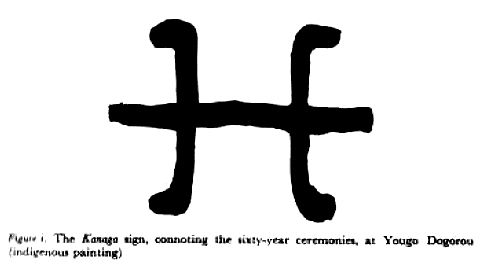
More consistent
evidence of the celebration of the Sigui is provided by the large
wooden mask, whose carving is one of the major concrete purposes of
the ceremony. This mask - usually of considerable size18 - is seldom
used, and is kept in some shelter or
hideaway in the rocks, along with those which have been carved at
previous ceremonies.
The care with which these masks are treated -
for in some ways they are the village archives - means that it is
not uncommon to come across series of three or four of them, the
oldest of which date back, respectively, to 1780 and 1720,16 give or
take a year or two. In exceptional cases, when the shelter has been
well selected and under constant surveillance, the series may be
longer still; thus at Ibi, in 1931, nine poles were counted, and
these must have succeeded three more which had been reduced to a few
fragments and piles of dust and were still visible; as were the
special places earmarked for them at the back of the shelter, all
perfectly protected from the damp, vermin and animals. The oldest in
the series of nine, which showed a continuous progression of ageing
in the course of time,17 thus date from the beginning of the
fifteenth century; and if the three others are taken into account,
the remnants of the earliest would date back to the first half of
the thirteenth century.18
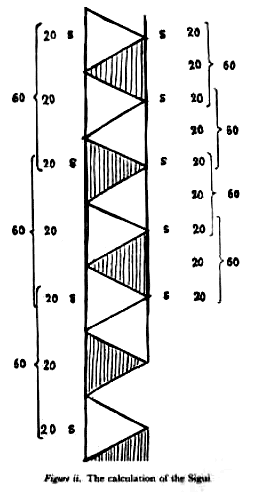
It is not easy to come across material evidence dating back further
than the traces of these poles at Ibi. But there is another object,
existing in a single edition, which is fashioned during these Sigui
ceremonies and which might also, be a significant milestone in the
calculation process. With the festival in mind, each regional Hogon,
as well as the supreme Hogon of Arou, has a fermentation stand woven
out of baobab fibres; this stand is used during the preparation of
the first ritual beer.
This beer is distributed in small quantities
to each family; it is then added to everybody's cup, and thus
ensures the homogeneousness of the beer drunk by the community. In
addition to this, all the other fermentation stands are associated,
by contact, with the principal one, which is exceptionally large:
the lid measures 40 cm. (16 in.) in diameter, and the four 'pompoms'
are the size of the normal object. As a result, it can only enter
the large jars.
These objects are kept in the Hogon's house where they are hung from
the main l»ram, and thus form a permanent sequence. Ongnonlou saw
six or seven of them in the official residence of the Hogon of Sanga;
the latter, one of the oldest men in Dogon
country, has it that his great-great-grandfather had seen eight
others which preceded the oldest in the present series.19
Assuming a
total of fourteen objects for the Sanga
chieftaincy, the first - which almost certainly does not denote the
first ceremony held in this region - would have been woven in the
twelfth century, if one reckons on the period separating two Siguis
being sixty years.
Again, Ongnonlou counted a series of eight in the house of the
supreme Hogon of the Arou, at Arou-by-Ibi. But he adds that the
number 'should' be twenty-four, although he cannot explain if there
is an ideal series which a complete sequence would aim for, or
which, conversely, would correspond to reality if the fibers had not
turned to dust..20
The methods described above for both keeping track of the ceremonies
and for calculating the intervals between Siguis are simple and tend
to be mnemotechnic. For the initiate they simply act as understudies
for other more complex practices and knowledge
to do with the Sirius system.
The Dogon names for this star - sigi
tolo, star of the Sigui;21 or yasigi tolo, star of Yasigui22 -
sufficiently indicate its relation with the ceremony of the
renovation of the world which takes place every sixty years.
Sirius, however, is not the basis of the system: it is one of the
foci of the orbit of a tiny star called Digitaria, po tolo,23 or
star of the Yourougou,24 yurugu tolo, which plays a
crucial role, and which, unaided as it were, hogs the attention of
male initiates.
This system is so important that, unlike the systems of other parts
of the sky, it has not been assigned to any particular group. In
effect the Ono and Domino tribes govern the stars, the former
including Venus rising among its attributes, the latter Orion's
belt. The sun should be assigned to the most powerful tribe, the
Arou; but so as not to be guilty of excess, the Arou handed the sun
over to the Dyon, who are less noble, and hung on to the moon.
As
far as the star Digitaria and the system to which it belongs are
concerned, these are common to all men.
THE ORBIT OF DIGITARIA
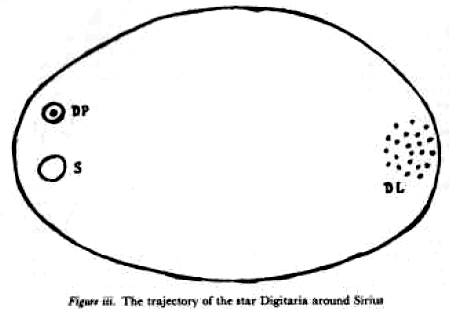
The orbit described by Digitaria around Sirius is perpendicular to
the horizon, and this Million
alluded to in one of the most common ceremonies in which masks play
a part:
The period of the orbit is counted double, that is, one hundred
years,28 because the Siguis are convened in pairs of 'twins', so as
to insist on the basic principle of twin-ness.29 It is for this
reason that the trajectory is called munu, from the root monye 'to
reunite', from which the word muno is derived, which is the title
given to the dignitary who has celebrated (reunited) two Siguis.
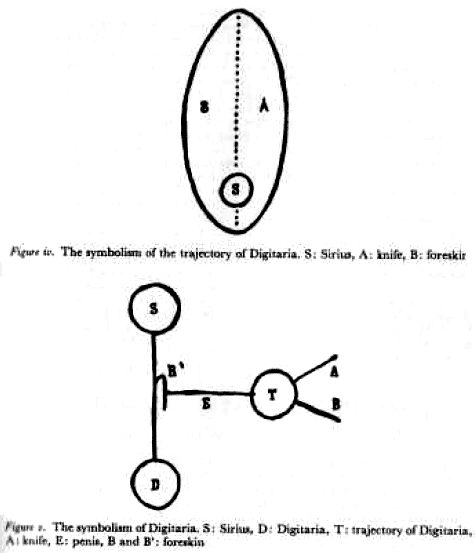
According to Dogon mythology, before the discovery of Digitaria the
supreme chief was sacrificed at the end of the seventh year of his
reign (the seventh harvest). This was the only computation known
about; the year-unit had not then been established. The spiritual
and material principles of the victim were conveyed to Digitaria -
to regenerate
the victim - whose existence was known but whose features had not
been revealed to man, because the star was invisible.
This was the rule for forty-nine years for the first seven chiefs
who thus nourished the
laba ozu po
ozugo po ya
(the path of the mask (is) straight (vertical) this path runs
straight)
But if one takes the pun into account - familiar to the initiated -
between po:25 'straight' and po: Digitaria, the translation becomes:
the path of the mask (is the star) Digitaria the path runs (like)
Digitaria.
A figure made out of millet pulp (fig. iii) in the room with the
dais in the house of the Hogon of Arou gives an idea of this
trajectory, which is drawn horizontally: the oval (lengthwise
diameter about 100 cm. = 40 in.) contains to the left a small
circle, Sirius (S), above which another circle (DP) with its centre
shows Digitaria in its closest position. At the other end of the
oval a small cluster of dots (DL) represent the star when it is
farthest from Sirius.
When Digitaria is close to Sirius, the latter
becomes brighter; when it is at its most distant from Sirius,
Digitaria gives off a twinkling effect, suggesting several stars to
the observer.
This trajectory symbolizes excision and circumcision, an operation
which is represented by the closest and furthest passage of
Digitaria to Sirius. The left part of the oval is the foreskin (or
clitoris), the right part is the knife (fig. iv).
This symbolism is also expressed by a figure used for other
performances2' (fig. v). A horizontal figure rests on a vertical
axis which connects two circles: S (Sirius) and D (Digitaria); the
centre of the figure is a circle T, which represents the trajectory
of D. The line E is the penis, the hook B' the foreskin. Two horns
hinge on the circle and reproduce once again the two parts of the
trajectory (cf. fig. iv): A, the knife; B, the foreskin.
Thus the
Sirius system is associated with the practices of renovating people,
and, consequently - in accordance with the Black mentality - with
the ceremonies which
But, having
discovered the star, the eighth chief resolved to avoid the fate of
his predecessors: with his son's complicity, he feigned death, lay
dormant for a few. months and reappeared before the chief who had
succeeded him; he announced that he had been to Digitaria, knew its
secrets, and that, from then onwards, every Hogon would reign for
sixty years - the period which would later separate one Sigui from
the next.30
Restored to office, he raised the level of the sky
which, hitherto, had been so close to the earth that it could be
touched,31 and he completely reviled the method of calculating time,
and the method of reckoning.
Until that time the ceremonies celebrating the renovation of the
world had in fact taken place every seventh harvest;32 the Hogon
made his calculations on the basis of five day periods, a unit which
established the week as it still is today, and five harvest cycles.
And as he was eighth in line, he counted eight cycles, in other
words forty years, and the number forty became the basis for
computation: the month had forty days, the year forty weeks (of five
days each).
But the Hogon lived sixty years, a number which was
interpreted as the sum of forty (basis of calculation) and twenty
(the twenty fingers and toes, symbolizing the person and thus, in
the highest sense of the word, the chief). Thus sixty became the
basis for calculations33 and it was first applied to establish the
period of time separating two Siguis. Although the orbit of
Digitaria takes approximately fifty years and although it
corresponds to the first seven reigns of seven years respectively,
it none the less computes the sixty years which separate two
ceremonies.34
As well as its movement in space, Digitaria also revolves (rotates)
upon itself over the period of one year and this revolution is
honoured during the celebration of the bado rite. On this occasion
it ejects from its three spirals the beings and the things which it
contains.
This day is called badyu, 'surly father', because it is
marked by a general movement of the world which upsets people and
places them in an unsure relationship with themselves and with each
other.
THE ORIGINS AND FEATURES OF DIGITARIA
The eighth Hogon instructed his people in the features of the star,
and, more generally, of the Sirius system.
Sirius appears red to the eye, Digitaria white. The latter lies at
the origin of things. 'God created Digitaria before any other
star'.36 It is the 'egg of the world', aduno ted, the infinitely
tiny and, as it developed, it gave birth to everything that exists,
visible or invisible.36 It is made up of three of the four basic
elements: air, fire and water.
The element earth is replaced by
metal.37 To start with, it was just a seed of Digitaria exilis,38
pi, called euphemistically kize uzi, 'the little thing',39
consisting of a central nucleus which ejected ever larger seeds or
shoots in a conical spiral motion (fig. vi). The first seven seeds
or shoots are represented graphically by seven lines, increasing in
length, within the sac formed in turn by an oval symbolizing the egg
of the world.
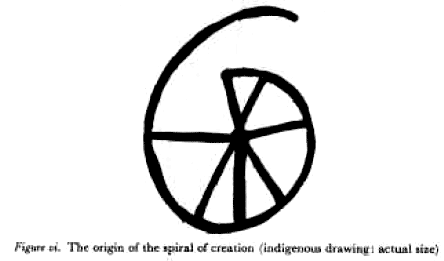
The entire work of Digitaria is summarized in a drawing whose
various parts are carried out in the following order :40 a vertical
line issues from the oval - the first shoot to emerge from the sac;
another segment, the second shoot, takes up a crosswise position,
and thus supplies the four cardinal points: the stage of the world.
The straightness of these two segments symbolizes the continuity of
things, their perseverance in one state.
Last, a third shoot, taking
the place of the first, gives it the form of an oval which is open
in its lower section, and surrounds the base of the vertical
segment. The curved form, as opposed to the straight, suggests the
transformation and progress of things. The personage thus obtained,
called the 'life of the world', is the created being, the agent, the
microcosm summarizing the universe.
In its capacity as the heavy embryo of a world issued each year, Digitaria is represented in Wazouba either by a dot or by a sac enveloping a concentric
circle of ten dots (the eight ancestral Nommos and the initial
couple of Nommo).
Its continual movement produces beings whose souls
emerge at intervals from the dots and are guided towards the star
Sorghum41 which sends them on to Nommo.
This movement is copied by
the rhombus which disperses the creation of the Yourougou in space.
Six figures are arranged around the circle, as if ejected from it
(fig. vii) :42
-
a two-pronged fork: trees;
-
a stem with four diagonal lines: small millet;
-
four dots arranged as a trapezium: cow with its head marked by a
short line ;43
-
four diverging lines starting from the base of a bent stem; domestic
animals;
-
four dots and a line: wild animals;
-
an axis flanked by four dots: plants and their foliage.44
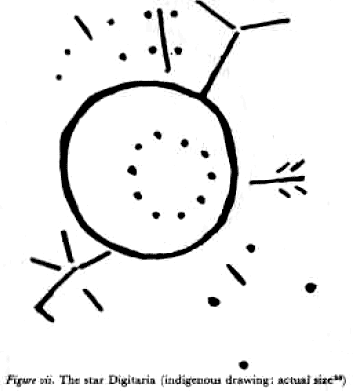
The original work is likewise symbolized by a filter-basket made of
straw called nun goro, 'bean cap'. This utensil consists of a sheath
in the form of a continuous helical spiral, the centre of which
starts at the bottom.45 The spiral supports a network of double
radii.46 The spiral and the helix are the initial vortical motion of
the world; the radii represent the inner vibration of things.
Originally, then, Digitaria is a materialized, productive motion.
Its first product was an extremely heavy substance which was
deposited outside the cage of movement represented by the
filter-basket.47 The mass thus formed brought to mind a mortar twice
as big as the ordinary utensil used by women.48 According to the
version told to the men, (his mortar has three compartments: the
first contains the aquatic beings, the second, terrestrial beings,
and the third, the creatures of the air. In reality the star is
conceived of as a thick oval forming a backcloth from which issues a
spiral with three whorls (the three compartments).
According to the version instructed to the women, the compartments
are four in number and contain grain, metal, vegetables and water.
Each compartment is in turn made up of twenty compartments; the
whole contains the eighty fundamental elements.
The star is the reservoir and the source of everything: 'It is the
granary for every thing in the world.' The contents of the
star-receptacle are ejected by centrifugal force, in the form of
infinitesimals comparable to the seeds of Digitaria exilis which
undergo rapid development :
''The thing which goes (which) emerges
outside (the star) becomes as
star, and enabled it to renovate the world periodically. Enlarge as it every day.51 In other words, what issues from the star
increases each day by a volume equal to itself.
Because of this role, the star which is considered to be the
smallest thing in the sky is also the heaviest:
'Digitaria is the
smallest thing there is. It is the heaviest star:''52
It consists of
a metal called sagala,53 which is a little brighter than iron and so
heavy 'that all earthly beings combined cannot lift it'. In effect
the star weighs the equivalent of 480 donkey-loads54 (about 38,000
kg. = 85,000 lb.), the equivalent of all seeds, or of all the iron
on earth,6' although, in theory, it is the size of a stretched
ox-skin or a mortar.
THE POSITION OF DIGITARIA
The orbit of Digitaria is situated at the centre of the world, 'Digitaria
is the axis of the whole world,''56 and without its movement no
other star could hold its course.
This means that it is the master
of ceremonies of the celestial positions; in particular it governs
the position of Sirius, the most unruly star; it separates it from
the other stars by encompassing it with its trajectory.
OTHER STARS IN THE SIRIUS SYSTEM
But Digitaria is not Sirius's only companion: the star emme ya,
Sorghum-Female, is larger than it, four times as light (in weight),
and travels along a greater trajectory in the same direction and in
the same time as it (fifty years). Their respective positions are
such that the angle of the radii is at right angles. The positions
of this star determine various rites at Yougo Dogorou.
Sorghum-Female is the seat of the female souls of all living or
future beings." It is euphemism that describes them as being in the
waters of family pools: the star throws out two pairs of radii
(beams) (a female figure) which, on reaching the surface of the
waters, catch the souls.
It is the only star which emits these beams which have the quality
of solar rays because it is the 'sun of women', nyan nay, 'a little
sun', nay dagi. In fact it is accompanied by a satellite which is
called the 'star of Women', nyan tolo, or Goatherd, enegirin
(literally: goat-guide), a term which is a pun on emme girin
(literally: sorghum-guide). Nominally then it would be more
important as the guide of Sorghum-Female. Furthermore, there is some
confusion with the major star, the Goatherd, which is familiar to
everyone.
The star of women is represented by a cross,58 a dynamic sign which
calls to mind the movement of the whole Sirius system (fig. viii).
Sorghum-Female is outlined by three points, a male symbol of
authority, surrounded by seven dots, or four (female) plus three
(male) which are the female soul and the male soul (fig. ix).
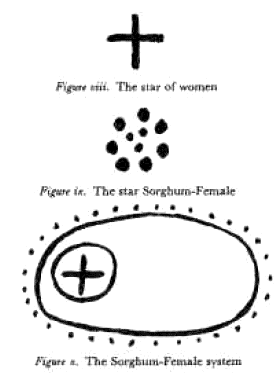
Taken as a whole, the Sorghum-Female system is represented by a
circle containing a cross (the four cardinal directions), whose
centre consists of a round spot (the star itself) and whose arms
serve as a receptacle for the male and female souls of all beings.
This figure, called the 'Sorghum-Female pattern', emme ya tonu,
occupies one of the Centres of an ellipse called 'the pattern of
men', anam tonu, consisting of a full line called the 'goatherd's
course', enegirin ozu, flanked by two dotted lines, the outside of
which is the path of the male souls, and the inside the path of the
female souls (fig. x).
The Sirius-Digitaria-Sorghum system is represented by a 'pattern of
the Sigui', sigi tonu, consisting of an oval (the world) in which
one of the centres is Sirius. The two alternate positions of
Digitaria at the time of the Sigui are marked and the positions at
the same moment of Sorghum-Female are marked on two concentric
circles encompassing Sirius.
The Sirius system as a whole is drawn at Sanga in different ways, in
particular at the bado ceremony.
On the facade of the residence of
the great Hogon of Arou and inside the official houses assigned to
the Hogons of Dyon, the course of these stars is represented by 'the
pattern of the master of the star of the Shoemaker', dyan tolo bana
tonu (fig. xi), composed of a vertical axis supporting, two-thirds
of the way up, a bulge, Sirius (S), and broken at its base to form
an elongated foot jutting to the left at right-angles, the course of
the star of the Shoemaker (C).
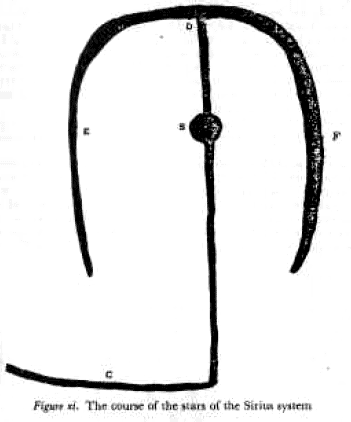
It is topped by a semi-oval whose
arms extend quite low down; the meeting-point (D) with this oval
symbolizes Digitaria, whose course is traced by the right arm (F).
But this arm is also the star of women whilst the left arm is
Sorghum-Female (E).
The lower part of the axis (SC), longer than the
upper part (SD), reminds one that the Shoemaker (C) is farther than
Sirius is from the other stars, and revolves in the opposite
direction.
Thus it is that during the bado ceremony the oldest woman of the
family draws, at the entrance to the house, the 'pattern of the
world of women', nyan aduno tonu,59 or 'pattern of the top and
bottom of the world', aduno dale donule tonu (fig. xii).
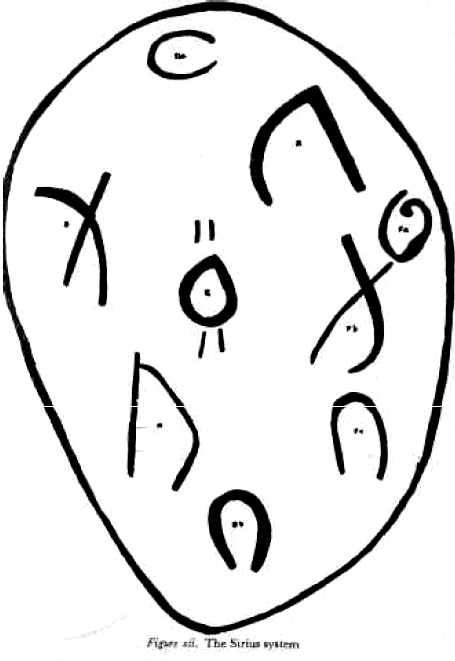
It consists of an oval, the egg of the world, containing nine signs:
-
Da. - Digitaria. The open curve on the right indicates the
acceptance of all the substances and matter placed in it by the
Creator.
-
Db. - Digitaria in its second position. The open oval below marks
the exit of the matter which spreads across the world; A and B also
indicate the extreme positions of Digitaria in relation to Sirius.
-
/ The star Sorghum-Female, counterpart of Digitaria. As it is the
'sun of women', It ii placed at the centre of the egg, like the sun
at the centre of the solar system. The oval It framed by two times
two small vertical lines symbolizing the rays emitted by the star.
-
S. - Sirius, 'star of the Sigui' or 'star of Yasigui'. The sign, so
placed that it materializes
the liaison worked by Sirius between the two stars described above,
consists of a kind of X with one right arm - the ant, key - dividing
a curved arm, the lower part of which is Yasigui; and the other part
the piece of the organ which is detached during excision. Although
female, the ant is here depicted by a straight rod, as if it were a
man. This marks its domination of Yasigui's feminity, for Yasigui is
maimed.
-
R. - The Yourougou. A hook, made up of a circular arc and a straight
segment indicates that the first movement of the Yourougou describes
a curve which goes around the sky; falling short of the goal, it
descended directly, as is shown by the right-hand segment which is
also the piece of bared placenta60.
In effect, with Digitaria as the egg of the world (see earlier) this
latter was split into two twin placentas which were to give birth
respectively to a pair of Nommo Instructors. What happened, however,
was that a single male being emerged from one of the placentas; in
order to find his twin, this being tore off a piece of this
placenta, which became earth. This intervention upset the order of
creation: he was transformed into an animal, the pale fox, yuruga,61
and communicated his own impurity to the earth, which rendered it
dry and barren.
But the remedy to this situation was the sacrifice,
to the sky, of one of the Nommo Instructors which had issued from
the other placenta, and the descent of his twin to earth with
life-giving, purifying rain.'2 The destiny of Yourougou is to pursue
his twin to the end of time - the twin being his female soul at the
same time. On the mythical level, Digitaria is thus considered to be
the Yourougou held in space by Nommo, relentlessly revolving around
Sirius, or Yasigui in other words, and never capable of reaching it.
-
N. - The figure of the Nommo consists of a vertical segment, Nommo
in person, upon which, and slightly below the upper edge, rests a
line broken into three unequal parts; the first is the seat of
future female souls; the second the seat of the souls of the dead;
and the third the seat of living souls.
-
Fa. - The star of Women, nyan tolo. An embryonic spiral calls to
mind that it is the satellite of Sorghum-Female.
-
Fb. - The 'sign of women', nyan tonu, consists of a diagonal line,
man, cut by a line which ends in a convex curve, woman. This shows
the contact between the sexes.63 The rod is upright with
astonishment at the sight of creation, which started with the system
of women. Woman is a heavy-bellied profile, ready to give birth.
-
Fc. - The sex of women is depicted by an oval which is open in the
lower part, womb-world, ready for procreation, gaping downwards to
spread the seeds.
THE SIRIUS SYSTEM AMONG THE BAMBARA
The Bambara call Sirius 'the star of the foundation', sigi dolo,
which is the same term Used by the Dogon, and like them they call
the star Digitaria fini dolo. "The expression fa" dolo fia, 'the two
stars of knowledge', is generally attributed to it, because 'it
represents in the sky the invisible body of Faro', conceived as a
pair of twins.65 This name also implies that the star is the seat of
all learning.
The Sirius system is depicted on the chequered blanket called koso
wala, 'colored picture', consisting of ten sequences made up of
some thirty rectangles coloured alternately indigo and white which
symbolize, respectively, darkness and light, earth and sky, and, in
Bambara mythology, Pemba and Faro.
Scattered throughout there are
twenty- three rectangles with different patterns of small stripes
placed in the direction of the thread, alternating the indigo, white
and red. Twenty of them represent stars or constellations; the other
three respectively represent the rainbow, hailstones and rain. The
fifth sequence in the centre, in which there is no coloured
rectangle, symbolizes the Milky Way. The ninth sequence, at one end,
contains five black (not indigo) rectangles
which point to the 'fifth creation, in darkness, which will occur
with the arrival of the waters to come'.66
Sigi dolo is first depicted alone 'in the cold season and in
impurity' by the ninth rectangle (third sequence); it is next
depicted flanked by fa dolo fla (two red lines) in the fifteenth
rectangle (eighth sequence).67
In Bambara mythology, Sirius represents Mousso Koroni Koundye, twin
of Pemba, maker of the earth, a mythical woman whom he chased
through space and was never able to catch.
In every respect Mousso
Koroni Koundye is comparable to Yasigui.68
She inaugurated
circumcision and excision and, as a result, Sirius is the star of
circumcision, for both Bambara and Dogon alike.
THE SIRIUS SYSTEM AMONG THE BOZO
The system is also known to the Bozo, who call Sirius sima kayne
(literally: sitting trouser) and its satellite tono nalema
(literally: eye star).
Back to Contents
Notes
-
A member of the Bambara living in Bandiagara also confirmed the
most important features of the system,
-
Various pieces of information were supplied direct by the people
of Yougo-Dogorou in 1931, 1936, 1948, 1949 and 1950.
-
We ourselves accepted this figure in 1931 and it can safely be
retained for the time being.
-
Cf. Griaule, Masques Dogons, Travaux et Memoires de l'lnstitut
d'Ethnologie de l'Universite" de Paris, vol. xxxiii (1938), chapter
1.
-
Ibid., pp. 167 ff., where this fault in the rock is described in
detail.
-
The Dogon are divided into four tribes, each of which had a
different role at one time. The four are the Arou (soothsayers), the
Dyon (farmers), the Ono (merchants), and the
Domino (who were confused in this respect with the Ono).
-
The spot is called tana tone; cf. Griaule, op. cit, p. 171.
-
Or 1933.
-
Probably in 1961 or 1963, if this computation is valid. (The
information came from a
prominent member of the Yougo aged between fifty-five and sixty.) It
is a matter of common knowledge that the next Sigui will not be
celebrated for another ten years or so (we were told this in late
1950).
-
These figures are described in M. Griaule and G. Dieterlen, 'Signes
graphiques soudanais' L'Homme, 3 (Paris: Hermann).
-
The Dogon count a week of five days as six days, just as in French a
week of seven days is referred to as 'eight days' and a fortnight as
'fifteen days'.
-
For a discussion of this substitute for God the Creator cf. Griaule,
Dieu d'eau, Paris, Editions du Chene, 1948.
-
For a description of the mask cf. Masques Dogons, pp. 470 ff.
-
This information came from a prominent member of the Yougo Dogorou.
According to all the initiates, the kanaga mask represents on the
one hand the static gesture of the god, and on the other hand the
swastika, through the repetition of the same gestures at an angle of
90 deg. to the first. The second figure represents the god whirling
round as he comes down to earth to reorganize the world in chaos.
-
The largest known example is ten metres long. It was brought back by
the Dakar-Djibouti Mission and given to the Musee de l'Homme in
Paris; cf. M. Griaule, Masques Dogons, pp. 234 ff.
-
Thus the Yendoumman Damma niche contains three specimens; the
Yendoumman Banama contains four; the Yendoumman Da, three; the Barna,
four; and the Ennguel-du- Bas, three. Cf. M. Griaule, Masques Dogons,
pp. 24a ff.
-
Ibid., pp. 245 ff.
-
For another index that enables us to establish the minimum age of
some of the villages, cf. Griaule, 'Le Verger des Ogol (Soudan
francais)', Journal de la Societe des Africainistes, xvii,
pp- 65-79
-
The Hogon of Sanga, who was enthroned in 1935, was thus the oldest
man in the area at that date (i.e. the oldest of the Dyon). If we
agree that he was born in about 1855, his
great-grandfather, who, he claims, was very old when he himself was
a young goatherd, w.is probably born between 1770 and 1780.
-
Each fermenting-receptacle is evidence of the Sigui for which it was
woven and is known as such. This means that these objects form a
sequence that is considered by the people to be more than purely
numerical.
-
BO. The period indicated by a scries of this kind would be 1,440
years by the time the next Sigui came round. It would apparently
correspond to the sequence of sixty reigns in which each Hogon
appears and which itself covers a period of about 1,500 years. The
supreme chiefs of the Arou tribe are in fact chosen when still
young, unlike the practice current among the other tribes. The
average reign is likely to be twenty-five years.
a 1. Sigo dolo in Bambara.
-
For a discussion of this mythical figure, who corresponds to the
Bambaras' Mousso Koroni, see later in this article.
-
The po, Digitaria coilis is commonly called 'fonio' in West Africa.
-
For a discussion of this mythical figure see later in text.
-
In the song the vowel becomes slightly nasal.
-
The saying that 'if you look at Digitaria it's as if the world were
spinning (po tolo yenehe aduno gonode ginwo) was probably coined to
convey this impression.
-
cf. M. Griaule, 'Signes graphiques des Dogon', in M. Griaule and G.
Dieterlen, 'Signes graphiques soudanais', L'Homme, 3 (Paris,
Hermann).
-
In the system of notation based on the figure 80 this number is
called '80 and 20'. The period of fifty years is very close to that
of Sirius's companion. Cf. P. Baize, 'Le Compagnon de Sirius',
L'Astronomie (Sept. 1931), p. 385.
-
For a discussion of this principle cf. Griaule, Dieu d'eau, pp. 183
ff.
-
After this reform the Hogons' sacrifice was replaced by animal
sacrifice.
-
This belief still obtains among the Dogon, and also among many other
peoples; cf. Griaule, Jeux Dogons, Travaux et Mimoires de L'Institut
d' Ethnologic de l'Universite de Paris, vol. xxxii.
-
For a discussion of the symbolism attached to the number 7 cf.
Griaule, Dieu d'eau, p. 60.
-
The figure 60 is the old base of the system of notation still used
in the Sudan for a number of ritual calculations. In several
Sudanese languages 60 is known as the 'Mande calculation', because
the system is believed to have spread from Mande. Nowadays the
various districts use 80 as a base for their calculations. Cf. G.
Dieterlen, Essai sur la religion bambara (Paris:
PUF).
-
There is a contradiction here that has not so far been solved. On
the one hand the Dogon accept that Digitaria is in orbit for fifty
years and this figure governs the way the Sigui is calculated. On
the other hand Siguis are held at sixty-year intervals.
Nevertheless, it should be noted that the date of the last Sigui,
which was celebrated at the very beginning of the twentieth century,
was allegedly brought forward. Does this indicate that the date was
regularly brought forward for each ceremony? The uninitiated would
thus be kept going with the idea that the official period was sixty
years and that, for accidental reasons, it happened to be reduced to
a half-century.
The foregoing myth is given here as an indication of the changes or
combinations in the system of computation that occur in the
'history' of the black peoples.
-
po tolo amma tolo la woy manu.
-
According to Innekouzou, po tolo, 'Digitaria star', has a hidden
etymological derivation from polo to, 'profound beginning'.
-
See below.
-
The Digitaria seed is made up of four parts, only one of which, the
outer casing, has a name, kobu. The other three are known as yolo.
-
This expression is always being used by Manda, whose extremely
punctilious mind thus avoids even mentioning the name of one of the
most basic tabus of the totemic priests.
-
For further details cf. Griaule, 'Signes graphiques des Dogons'. See
also Griaule, 'L'imagc du monde au Soudan', Journal de la Societe
des Africainistes, xix, 2, pp. 81-89.
-
Cf. below.
-
They are counted clockwise, starting from the highest figure on the
right-hand side.
-
This cow is an avatar of the Nommo.
-
It should be remembered that the Dogon, like the other black
peoples, use several different symbols or even several different
sequences of images to express a single idea or object. Conversely,
a symbol often represents several different things.
-
The shape of this basket is roughly the same as the outline of a
mortar.
-
On the system of symbols represented by this basket.
-
It is understood that Digitaria was the same shape as a basket, but
was not a basket.
-
The initiates have a different idea of these dimensions.
-
aduno kize fu guyoy.
-
This drawing is executed in Wazouba inside the sanctuaries during
the festival of agu.
-
kize wogonode para gwdy wokuwogo dega bay tuturu byede.
-
po tolo kize woy wo gayle be dedemogo wo sige be,
33.
-
This has the Same root as sagatara, 'strong, powerful' (native
etymology).
-
The number 480 is the product of the base number 80 times the number
of tens in the base number 60, which was formerly in use. It is used
here to symbolize the largest number of all.
-
Versions of, respectively, Innekouzou, Manda and Ongnonlou.
-
po tolo aduno fu dudun gowoy.
-
The men have two twin-souls of different sexes. Cf. Griaule, Dieu
d'eau, pp. 183 ff. The same idea is current among the Bambara, cf.
Dieterlen, Essai sur la religion Bambara, chapter 3.
-
The figures reproduced here are used in Wazouba.
-
This figure was taught to Ongnonlou in August 1950, by the Hogon of
Sanga.
-
Yourougou, who was born a single being, is fated to pursue the
female soul that is his ideal twin to the end of time. In particular
he tried to seize it by snatching away from his mother, the Earth,
part of the placenta that emerged after he was born, because he
thought it was his twin soul.
-
Vulpes pallida.
-
Cf. Griaule and Dieterlen, *Le harpe-luth des Dogon', Journal de la
Societe des Africainistes, xx, 2.
-
A man could just as well call it anam tohu, 'drawing of men'.
-
Fini, from which fonio, a word used throughout Sudanese Africa, is
derived, is the same word as po.
-
The expression may possibly indicate the Sirius and Digitaria
grouping, or Digitaria and another companion. For Faro, or Fanro,
the Bambara equivalent of the Dogon Nommo, cf. Dieterlen, Essai sur
la religion Bambara, chapters 1 and 2.
-
Cf. ibid., chapter 1. This refers to a future world that will be
heralded by flood-waters.
-
The koso wata blanket, which is worn by elderly initiates at the
major Bambara institutions
(dyo), belongs to a series of eight ritual blankets with patterns
and colours representing mythology, cosmology and the social
structure. They are used at night or worn as clothing, depending on
the status, duties and aims of the wearer. Apart from their economic
value, they are evidence of the wearer's knowledge. Their ritual use
is plain, particularly during marriage ceremonies. The Dogon have
similar blankets. The one known as yanunu represents a sort of very
rough map of the world showing the most important stars.
For a discussion of the way the Bambara and Dogon set great store by
weaving and the various cotton strips, cf. Dieterlen, Essai, chapter
5, and Griaule, Dieu d'eau.
-
For a discussion of the parallels between Mousso Koroni Koundye
and Yasigui, cf. Dieterlen, Essai, chapter 1. For a discussion of
Mousso Koroni Koundye, Pemba and Faro, cf. S. de Ganay, 'Aspect de
mythologie et de symbolique bambara', Journal de psychologie normale
et pathologique (April/June 1949); Dieterlen, Essai, chapters 1 and
2.
|








